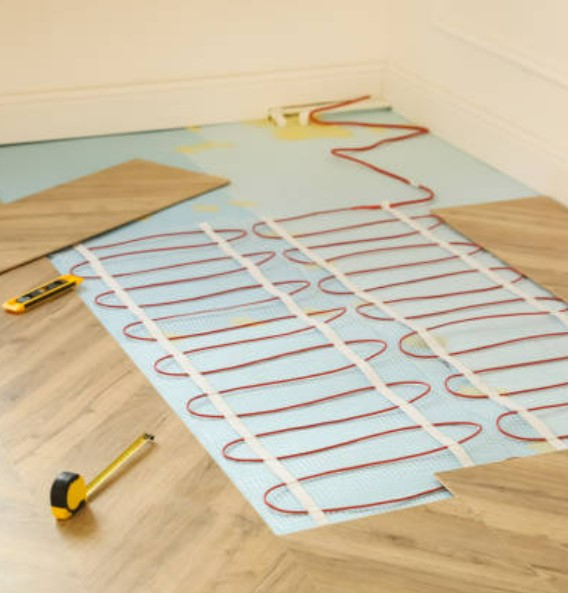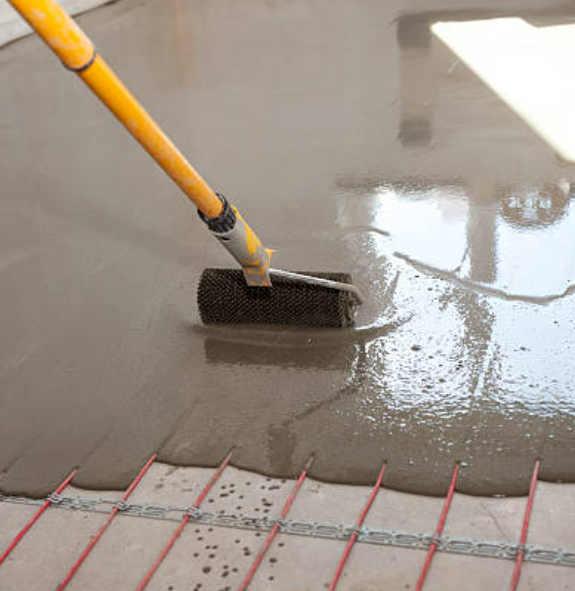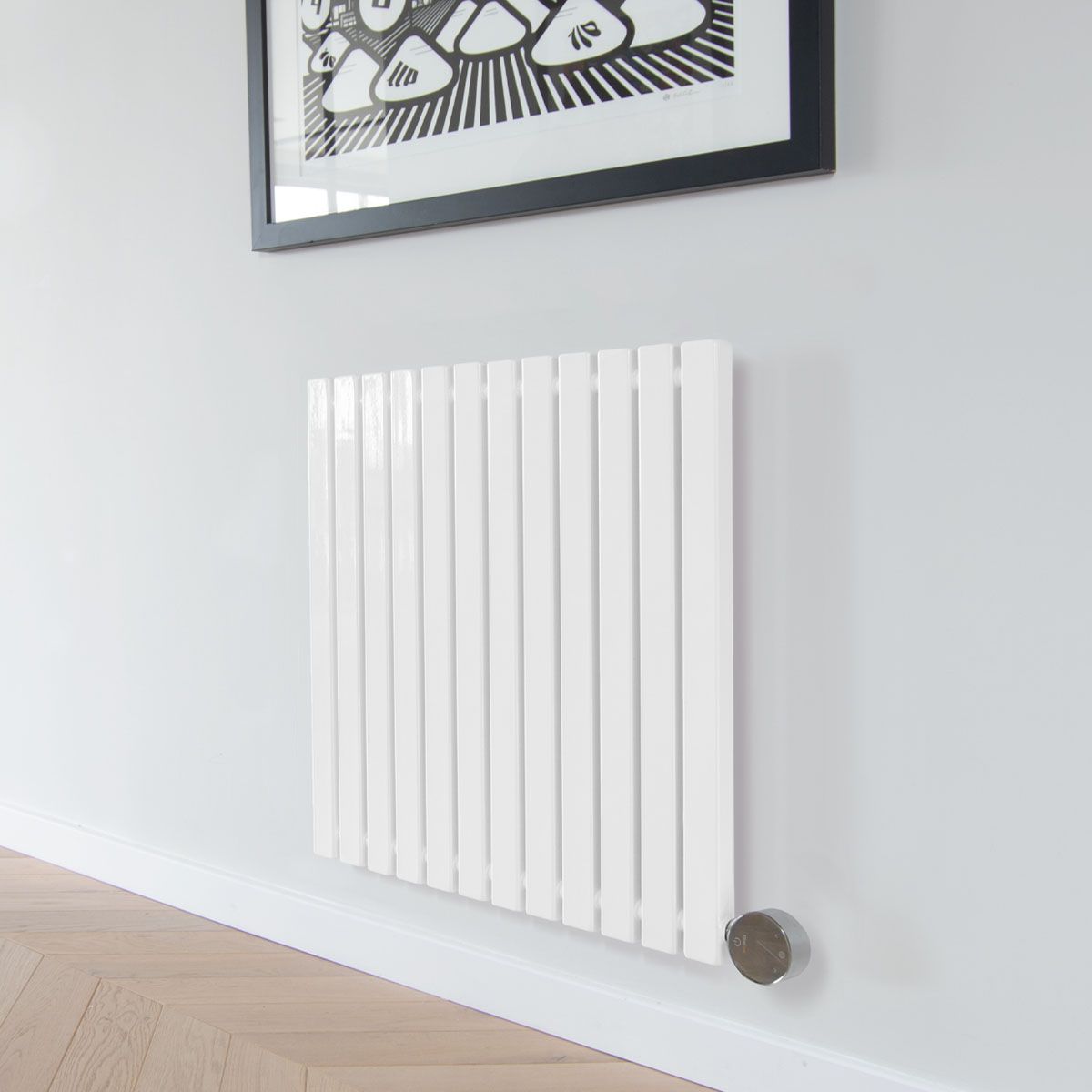

Electric heating takes many forms, and today we’re comparing electric radiators and underfloor heating to see which is the best fit for your home. We’ll be diving into how they work, their pros and cons, and ultimately have them battle it out for the top spot.
Electric radiators
Electric radiators are the intuitive, efficient, and low carbon alternative to traditional gas central heating. With a range of styles and programming options, they’re a truly versatile solution and the ultimate “use anywhere” heater.
How they work
Electric radiators work very similarly to central heating radiators, except they don’t need connecting to a centralised unit or pipe network and use an internal metal heating element to create warmth. Electric radiators emit their heat as both convection and radiation, which result in an ideal combination of gentle, long-lasting, yet responsive warmth.
The three types of electric radiators:
1. Ceramic – metal wires are baked inside ceramic blocks, supplying greater levels of radiant warmth – great for those harder-to-heat spaces. With slightly slower warm-up times, temperatures are maintained for a long time after the radiator has stopped drawing power.
2. Oil-filled – specially engineered thermal fluid circulates the radiator – it’s slower to reach max temperatures but also slower to cool down, maximising efficiency.
3. Dry thermal – using neither ceramic or oil, iron heating rods are pushed through a specially designed aluminium body, making the radiator highly responsive with quick heat up and cool down times.
Programming:
- Precision digital thermostat – an integrated thermostat that reduces energy waste; it enables the radiator to maintain its heat without fluctuation.
- Smart control – programming can be done remotely via a WiFi connection, using either an app or voice control.
- Motion sensor – a cutting-edge feature of the Ecostrad iQ Ceramic and Haverland SmartWave electric radiators; the radiator is turned on when the sensor detects movement in the room.
Best suited for:
- Primary heating throughout your home
- All day use or as a top-up heater – whatever your preference
|
Pros |
Cons |
|
Many can be DIY-installed and require zero maintenance |
Some can take longer to reach max temperatures |
|
Heats through convection and radiation for responsive, long-lasting warmth |
Professional hardwiring is required for a full refurb and when installing in bathrooms |
|
Many are lightweight and portable |
|
|
Huge variety of styles to suit any interior design scheme |
|
|
Smart programming options including a motion sensor |
|
|
Many are fitted with precise digital thermostats for accurate temperature control |
|
|
100% efficient at point of use |
Underfloor heating
Did you know underfloor heating was invented in Korea all the way back in the Bronze Age? Obviously, it’s come a long way since then, and modern-day homes can enjoy warm rooms and toasty feet with the help of underfloor electric heating. It’s a lot less complex than its gas alternative as, like all other forms of electric heating, it doesn’t need to be connected to your home’s pipe network to run.
How it works
Underfloor heating works by using a network of cables that are wired up to a thermostat and the mains electric. It’s able to generate heat in three different ways, primarily through radiation – but also via convection and conduction due to its placement in the floor. Warm feet make for luxurious comfort, and its lower temperature more closely mimics the comforting heat during a warm day.
The four types of underfloor electric heating:
1. Foil mat – heating cables are pre-spaced in an aluminium mat that is placed on top of the original flooring, with the floating floors placed directly above.
2. Sticky mat – heating cables are pre-spaced on a sticky mesh which is set into a thin layer of cement; works with any floor type.
3. Loose wire – unspaced reel of wire that can be hand-fitted to suit any floor type, especially useful for awkward layouts and corners.
4. Inscreed cables – cables fitted directly into the floor; complex installation but maximises efficiency.


Programming:
- Thermostat – installed in the wall; controls range from manual to more advanced programming.
- Smart control – smart thermostats can be linked to an app on your smart device to make remote changes, including schedules and heating boosts.
Best suited for:
- Additional or complementary heating, perfect for rooms with limited wall space
- Rooms with hard floors, typically kitchens and bathrooms
- All day use – set-and-forget heating
|
Pros |
Cons |
|
Invisible heating – ultimate space saver for small or “busy” rooms with limited wall space |
Installation is complex and is best done by a professional unless you have the DIY know-how |
|
Heats using radiation, convection and conduction – equalling comforting warmth and toasty feet |
Usually only suitable for rooms with concrete or wooden flooring |
|
Smart programming options |
Not suitable for on-demand heating – can take a few hours to reach max temperatures |
|
Can last decades before needing to be replaced |
Can be expensive to run – dependent on floor type and insulation |
|
Hot air rises – the floor is a great location for unhindered heat dispersion |
Requires large floor area to work optimally |
Electric radiators vs underfloor heating: the verdict
We’ve looked at the two individually – it’s time to pit them against each other to determine which is right for you.
Installation
Most types of electric radiators and underfloor heating can be DIY-installed, but there’s a lot more planning and consideration involved when installing your underfloor heating. You’ll have to plan your layout and prepare the subfloor surface before fitting both a floor and room sensor. Depending on the type, you’ll also need to set it with cement and lay the top floor covering. If you don’t have the experience or technical know-how, consulting a professional is always your best bet. Pricing depends on a number of factors, but it averages out between £50-£85 per m2. DIY-installing an electric radiator, on the other hand, is far simpler. With all fittings and fixtures included, it’s usually just a case of mounting it to the wall and plugging it into a 3-pin socket – ready to use in minutes.


Maintenance
No matter what form it takes, electric heating requires little maintenance. With no connection to pipework or a combustible fuel source, there’s not a lot that can go wrong. While underfloor heating typically has a longer lifespan than an electric radiator, if there is a fault, detecting and fixing the problem is much more complex considering it’s underneath the floor. With an electric radiator, a substitute part is much easier to replace and will be a much quicker process.
Controllability
Both radiators and underfloor heating can be programmed via app control if you invest in smart heating. While electric radiators have their thermostats built-in, thermostats for underfloor heating will be found on the wall which will just need connecting to your home WiFi. Boost temperatures, set weekly schedules and alternate between heating modes from anywhere in the world. As underfloor heating can take several hours to warm up – your heating schedule should reflect this longer wait time. Electric radiators are far more responsive, so are better matched if you prefer to make spontaneous changes rather than rely on a schedule.


Efficiency & Running Costs
Electric radiators are primed for use as a primary heat source, with a multitude of energy-saving features to slim down your heating bills. Underfloor heating, however, can be expensive if you use it throughout your home as its efficiency correlates directly with floor type and insulation levels. Electric radiators are better suited to deal with draughts and open plan spaces, and the floor type has no effect on the transfer of heat. To improve the efficiency of both, you can pair them with a renewable energy source or supplier for greener heating.
Final Verdict
We think underfloor heating is great in one or two rooms for that luxury feel – it’s particularly useful in bathrooms where floors will dry quickly after a shower, but as its slow heat-up times will mean you’ll need to keep it running throughout the day, costs will start to add up. Poor flooring and insulation also hinder its efficiency, affecting energy bills further.
That’s why electric radiators come out on top. Installation is quick and simple, maintenance is minimal and even if there is a fault, it’s a lot easier to deal with. Their versatility means they work as either a primary heat source that can be left running throughout the day, or used more sporadically for on-demand warmth. With a wealth of energy-saving features, slimming down running costs is a breeze.
Electric radiators: the worthy winner
Now you know why electric radiators are amongst the best heating solutions available, why not check out our extensive range? We’ve got luxury designer styles, reliable German models, and a mix of contemporary and traditional builds. Deck out every room of your home with the cost-effective and efficient warmth of an electric radiator, and don’t forget to check out our radiator calculator to find the perfect size. For more information on our products and all things electric heating, don’t hesitate to get in touch with our award-winning customer support team today.
Key takeaways
- Electric radiators and underfloor electric heating heat through convection and radiation. The unique placement of underfloor heating also means feet are kept warm for that luxury feel.
- Underfloor heating is more complex to install, its efficiency depends on floor type/insulation levels and is slow to reach max temperatures which makes it expensive to run.
- Electric radiators are incredibly versatile and make for a stylish option for home heating; they’re perfectly suited as both a primary heat source or top-up heater.
- Underfloor heating is best suited for installation in one or two rooms (mainly bathrooms and kitchens) as they’re not designed as a primary heat source.








